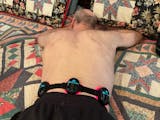Red light therapy is a growing wellness trend that harnesses the power of specific wavelengths of red and near-infrared light to stimulate the body's natural healing processes. According to recent statistics, the use of red light therapy has seen a notable increase, with an estimated 30% growth in usage over the past year. This non-invasive treatment is capturing attention for its wide range of potential benefits.
History of Red Light Therapy
1903-Finsen's groundbreaking research laid the foundation for the use of light in medical treatments.
1960s - Endre Mester was conducting experiments with lasers and observed that low-level laser light stimulated hair growth and wound healing.
1970s -NASA's research explored the potential of low-level laser therapy, including red and near-infrared light, for wound healing and tissue regeneration in space environments. Their findings contributed to the understanding of red light therapy's therapeutic applications on Earth.
1980s - Michael R. Hamblin conducted his research at the Wellman Center for Photomedicine, part of Harvard Medical School, among other institutions. His work has helped advance the scientific understanding of red light therapy.
Present Day: Red light therapy has continued to evolve and expand its applications. Research in this field is ongoing, and a growing body of evidence supports its effectiveness in diverse areas, including skin rejuvenation, pain management, wound healing, and more. Various scientists and institutions worldwide continue to contribute to the development of red light therapy.
What Are the Benefits of Red Light Therapy?
Red light therapy offers a diverse array of benefits, including skin rejuvenation, pain management, wound healing, hair growth, anti-inflammatory effects, improved blood circulation, mood enhancement, and more. These benefits are supported by scientific research and make red light therapy a versatile and promising solution for a wide range of health and wellness concerns.
Skin Rejuvenation:
Research such as "Low-Level Laser (Light) Therapy (LLLT) in Skin: Stimulating, Healing, Restoring" demonstrates that red light therapy stimulates collagen production and improves skin texture, reducing wrinkles and promoting a more youthful appearance.
Pain Management:
Scientific studies, including "The Use of Low Level Laser Therapy (LLLT) For Musculoskeletal Pain," indicate that red light therapy can modulate pain receptors and promote the release of endorphins, effectively reducing pain associated with various conditions, such as arthritis and musculoskeletal disorders.
Wound Healing and Tissue Repair:
Research in "The Effects of Low-Level Laser Therapy on Bone and Skin Repair" highlights the therapy's capacity to accelerate wound healing and tissue repair through increased cellular proliferation and collagen synthesis.
Hair Growth:
Studies like "Efficacy and Safety of a Low-level Laser Device in the Treatment of Male and Female Pattern Hair Loss: A Multicenter, Randomized, Sham Device-controlled, Double-blind Study" show that red light therapy can stimulate hair growth by enhancing blood flow to hair follicles and promoting the proliferation of hair cells.
Anti-Inflammatory Effects:
Scientific investigations, such as "Low-Level Laser Therapy in Inflammatory Conditions," illustrate red light therapy's ability to reduce inflammation by inhibiting pro-inflammatory cytokines and promoting anti-inflammatory mediators.
Improved Blood Circulation:
Studies like "Low-Level Laser Therapy (LLLT) and Tissue Viability" indicate that red light therapy's effect on nitric oxide production leads to improved blood circulation, facilitating oxygen and nutrient delivery to tissues.
Mood Enhancement:
Research such as "Photobiomodulation as a promising new tool in the management of psychological disorders: A systematic review" suggests that red light therapy may positively influence mood and reduce symptoms of depression, potentially through its impact on neurochemicals and circadian rhythms.
Muscle Recovery:
Studies, including "Effect of phototherapy (low-level laser therapy and light-emitting diode therapy) on exercise performance and markers of exercise recovery: a systematic review with meta-analysis," have shown that red light therapy can aid in muscle recovery and reduce post-exercise muscle soreness.
Circadian Rhythm Regulation:
Research in "Effects of Phototherapy on Circadian Rhythms and Sleep in Premature Infants" indicates that red light exposure can influence melatonin production, helping regulate circadian rhythms and improving sleep patterns.
What Are the Side Effects of Red Light Therapy?
Although red light therapy is generally considered safe, there are minimal side effects to be aware of. These can include mild eye strain if not used with proper eye protection. However, these side effects are rare and typically mild, ensuring that red light therapy remains a safe treatment option.
While red light therapy is generally safe, there are a few potential side effects and concerns to be aware of:
Is Red Light Therapy Safe?
Red light therapy is generally safe when applied correctly, following established protocols and safety guidelines. It is non-invasive and poses a low risk of causing burns or tissue damage. However, it's essential to use proper eye protection, as direct exposure to the eyes can be harmful.
Can Red Light Therapy Cause Cancer?
There is no conclusive evidence to suggest that red light therapy causes cancer. In fact, ongoing research is exploring the potential anti-cancer properties of this therapy, particularly in the context of cancer treatment and prevention.
Red light therapy has garnered significant attention for its wide range of potential benefits, supported by a rich history and scientific understanding. Its safety, non-invasiveness, and versatility make it a promising therapy for various health and wellness applications. Ongoing research continues to expand the horizons of this innovative approach.
















Share:
Does Red Light Therapy Work?